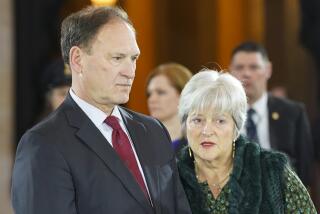Justice Sotomayor’s memoir a story of stubborn optimism
WASHINGTON — As an 8-year-old, Sonia Sotomayor stood on a chair next to the gas stove, boiled water and sterilized a needle.
“I’m going to give myself the shot,” she told her mother. Her father was drinking heavily, dying of alcoholism, and his hands trembled. Her mother was often away, working nights as a nurse.
Sonia had been diagnosed with juvenile diabetes, and she needed a daily shot of insulin. To avoid the screaming matches between her parents over it, she decided she would inject herself.
Sotomayor’s journey from the housing projects in the South Bronx was cited as an inspiring tale when President Obama chose her nearly four years ago for the Supreme Court. Now, the associate justice has written an unusually candid memoir of her early years that, if anything, makes her rise seem more improbable.
Her story is not one of a charmed child whose early brilliance was recognized by all. Instead, she tells of her doubts and insecurities. Because she spoke Spanish at home, she struggled at her Catholic school and found the nuns cold and cruel. On the streets, she heard taunts of “spics” directed at Puerto Ricans. And of her appearance, she writes, “I had a pudgy nose. I was gawky and ungraceful.” And, her mother informed her, she “had terrible taste in clothes.”
Hers is a tale of stubborn optimism. She was determined to learn, convinced she could succeed if given a chance. She credits affirmative action, still new in the early 1970s, with opening a door to the Ivy League, but once there, she excelled at Princeton University and Yale Law School.
On Monday, Sotomayor, 58, will have a highly visible role in the inauguration ceremony. She will give the oath of office to Vice President Joe Biden, who chose her for the honor.
And when the high court takes a midwinter recess beginning Tuesday, she will launch a speaking tour around the country to promote her book: “My Beloved World.”
Sotomayor is the third Supreme Court justice in recent years to write a memoir of childhood. Retired Justice Sandra Day O’Connor told of growing up lonely on a cattle ranch in the deserts of New Mexico. Clarence Thomas told of hunger and poverty before going to live with his grandparents in Savannah, Ga.
Sotomayor’s story is the most detailed. She describes an extended family of cousins, aunts, uncles and grandparents who came together regularly for meals, card games and gossip. For her, the embrace of family and community is more important than a sense of self-reliance.
“The figure of the lone visionary that enthralls so many young people … never called to me,” she writes. “My heroes were all embedded in the community.”
When called to deliver a speech in high school, she chose to talk of the tragic stabbing death of Kitty Genovese, whose cries for help outside of her Queens apartment in March 1964 were ignored by three dozen neighbors. “How did this happen? It happens when we forget we are a community, that we are connected to one another and have an obligation” to help others, she writes. She was recounting her performance, which won a contest, but it is clear she believes the same today.
Sotomayor, a liberal Democrat, and Thomas, a conservative Republican, are the court’s two minority justices, and their stories have many similarities, but also crucial differences.
Both say they benefited from the disciplined environment at their Catholic schools. Both were cared for at one time by a grandparent. Both were too poor to afford college, but went to Ivy League universities, thanks to affirmative action policies. And both later felt the sting of rejection by private law firms, despite their law degrees from Yale.
Thomas later concluded that affirmative action made his Yale degree nearly worthless because it “bore the taint of racial preference.”
Sotomayor said she felt “an undercurrent of hostility” at Princeton directed toward the affirmative action students who arrived in the 1970s, and she was taken aback when a partner at a Washington law firm opined that affirmative action was a “disservice to minorities.”
“When the anger, the upset and the agitation had passed, a certainty remained: I had no need to apologize that the look-wider, search-more affirmative action that Princeton and Yale practiced had opened doors for me,” she writes. “That was its purpose: to create conditions whereby students from disadvantaged backgrounds could be brought to the starting line.” But once there, she says, she made it her own, winning top honors at Princeton and a coveted spot on the Yale Law Review.
She writes that she never became a know-it-all lawyer who confidently spouts legal theories. She instead describes herself as someone who is always learning. “I have been a happy sponge,” she writes, “soaking up whatever lessons I could learn.”
Her book ends in 1992, when, to her delight, she is offered the job she wanted: federal district judge.
“Sonia, how wonderful! That’s terrific news!” her mother exclaimed, noting that it must mean a big pay raise. No, her daughter replied, explaining she would earn much less than at the law firm where she worked.
More travel? No, less, the new judge said. More interesting people? No, a procession of criminal defendants, she replied.
Her mother’s new husband, Omar, came to her rescue. “It must be very important work,” he offered.
More to Read
Sign up for Essential California
The most important California stories and recommendations in your inbox every morning.
You may occasionally receive promotional content from the Los Angeles Times.











